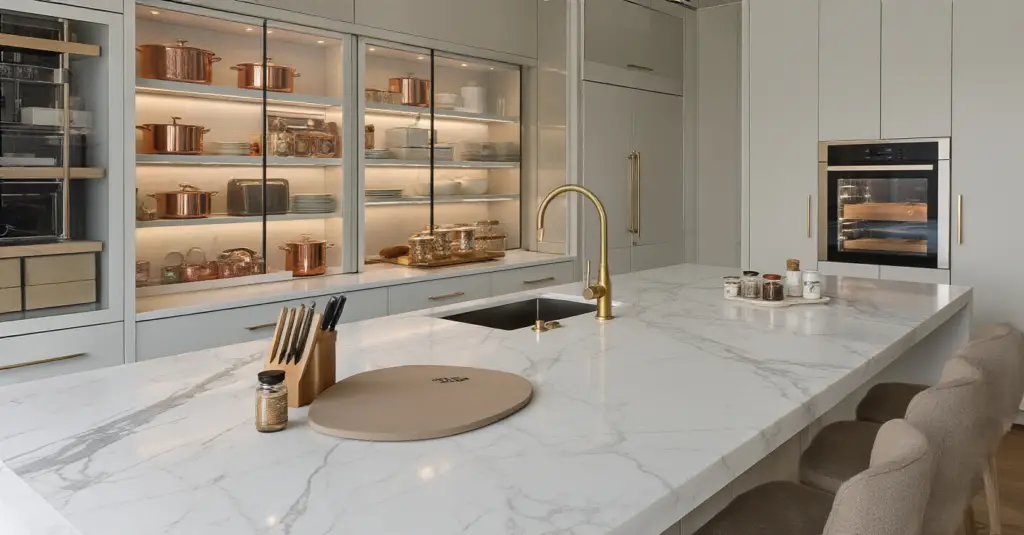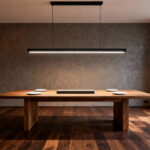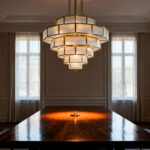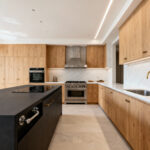Of course! Grab a cup of coffee. You asked me what goes into a real luxury kitchen renovation, and I’m so glad you asked me instead of getting lost in a sea of corporate blogs.
Picture this: You’re trying to host a holiday dinner. You’ve got a dozen people coming over. The turkey is in the oven, but you need to wash vegetables for a salad. Your brother-in-law is trying to get ice for drinks, blocking the fridge. And your niece is trying to find a snack, rummaging through the exact drawer you need for the whisk. It’s chaos. The kitchen is beautiful—it has all the trendy finishes—but it just doesn’t work.
That’s the difference. A true luxury kitchen isn’t just about spending a ton of money on fancy marble. It’s about creating a space that feels effortless. It’s a kitchen that works with you, whether you’re making Tuesday night tacos for the family or plating a seven-course meal for friends. It’s a space where memories are made without the stress.
So let’s break down what actually matters. Here are the 21 things you need to think about to create a kitchen that is not only stunningly beautiful but a complete joy to live and cook in.
Vision, Planning & Expert Design
This is the boring part, I know. But I promise you, getting this right saves you so much money and heartache later. This is the foundation. Don’t skip it.
1. Define Your Unique Lifestyle and Culinary Needs
Before you even think about a single finish or appliance, we need to talk about you. How do you actually live? Are you a baker who needs cold marble countertops for rolling dough? Or are you a busy family that lives on quick, healthy meals and needs a huge prep island and an organized pantry? Be brutally honest. A kitchen designed for a professional chef is totally different from one designed for a family that loves to host casual pizza nights.

I had a client once who insisted on this giant, single-level island she saw in a magazine. It was beautiful, but she was a passionate baker. We had to have a real heart-to-heart because that sleek quartz island was terrible for pastry, and there was no dedicated space for her stand mixer or proofing drawers. We redesigned it with a lower, built-in marble section just for her baking. She later told me it was the single best decision we made. Your kitchen should serve your life, not the other way around.
That gorgeous magazine kitchen might be a nightmare for you in real life. Let’s make sure yours is built for the life you have and the one you want.
2. Engage a Specialist Luxury Kitchen Designer and Architect Team
You know the saying, “too many cooks in the kitchen”? It’s even worse when your designer and your architect aren’t speaking the same language. Don’t just hire a designer and a builder separately and hope for the best. You need a team that has a history of working together. The architect handles the bones of the space—moving walls, ensuring the floor can hold that massive stone island you want—while the designer brings the vision to life with materials, flow, and function.

They need to be in lockstep from day one. I’ve seen projects go off the rails because the architect planned for standard-depth counters, but the designer specified a pro-grade range that stuck out by three inches. It sounds like a small thing, but it throws off the entire look and workflow. Your job is to find a team whose portfolio you love and whose communication style feels right. Ask them how they handle disagreements. Their answer will tell you everything you need to know.
Ultimately, this dream team is there to translate your vision into a cohesive, functional, and structurally sound reality. Their collaboration is what turns a good kitchen into an unforgettable one.
3. Establish a Comprehensive Budget with a Significant contingency fund
Let’s have the real talk. This is the least sexy part of the project, but it is, without a doubt, the most important. Whatever you think your dream kitchen will cost, add 20% on top of that for a contingency fund. I’m not kidding. Twenty. Percent. This isn’t “nice to have” money; it’s your project’s life raft. There will always be something unexpected when you open up walls—old plumbing, weird wiring, a hidden structural issue.
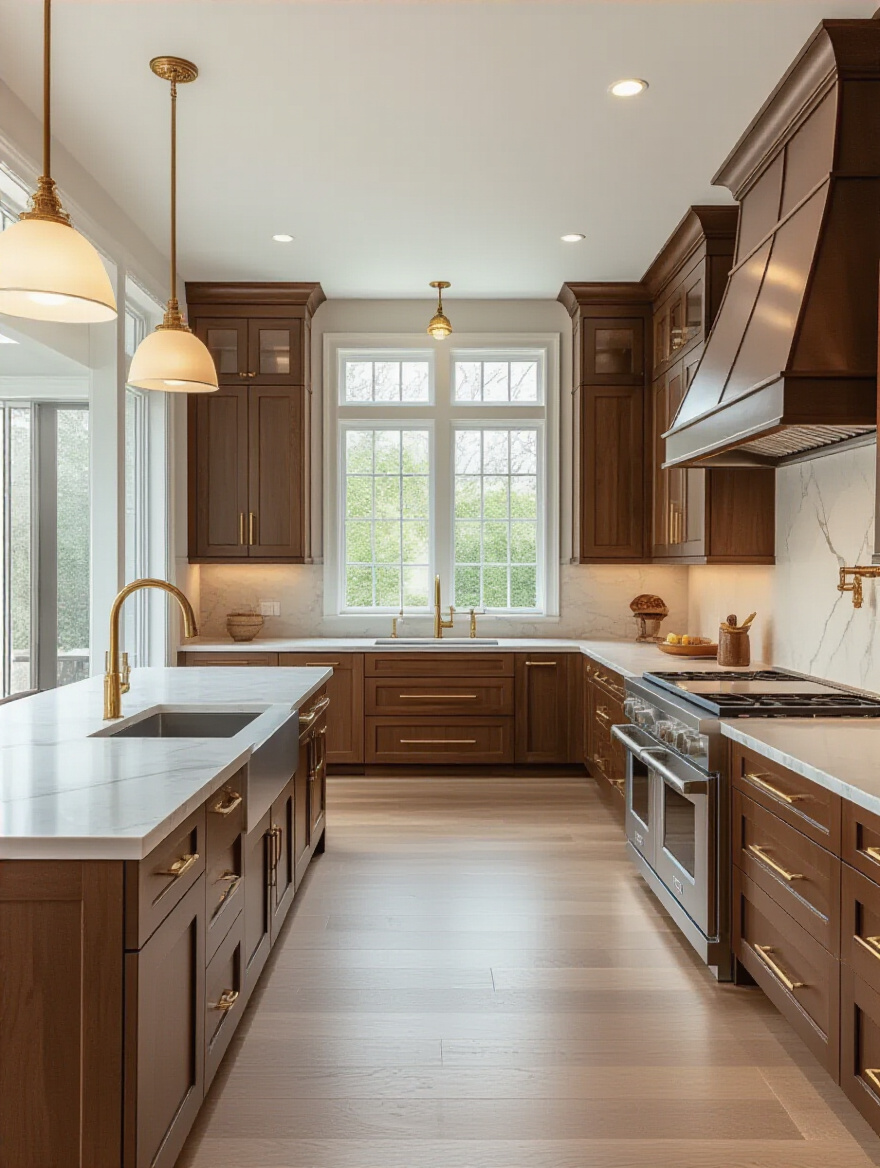
I learned this the hard way on one of my first big projects. The clients had a very specific, tight budget. We didn’t pad it enough. During demolition, we found a major support beam that was not on the original blueprints, right where their new pro range was supposed to go. Moving it cost thousands of dollars they hadn’t planned for, and they had to compromise on the custom cabinetry they’d been dreaming of. It broke my heart. A proper contingency fund means that when—not if—a surprise happens, it’s a problem to be solved, not a dream-crushing disaster.
This fund is your permission slip to keep the project on track and not have to sacrifice the details that make the kitchen special. Protect your vision by planning for the unexpected.
4. Optimize the Kitchen Layout for Ergonomics, Flow, and Entertaining
Can we talk about why everyone still obsesses over the “kitchen triangle”? It’s a fine starting point—the path between your fridge, sink, and stove—but modern kitchens have moved so far beyond that. I prefer to think in “zones.” You have a prep zone, a cooking zone, a cleanup zone, and often, a social zone. Where do you chop your vegetables? That area should have a cutting board, knives, compost bin, and maybe a small prep sink right there. Where do you make your coffee? That should be a dedicated station outside the main cooking path so no one is tripping over each other during the morning rush.
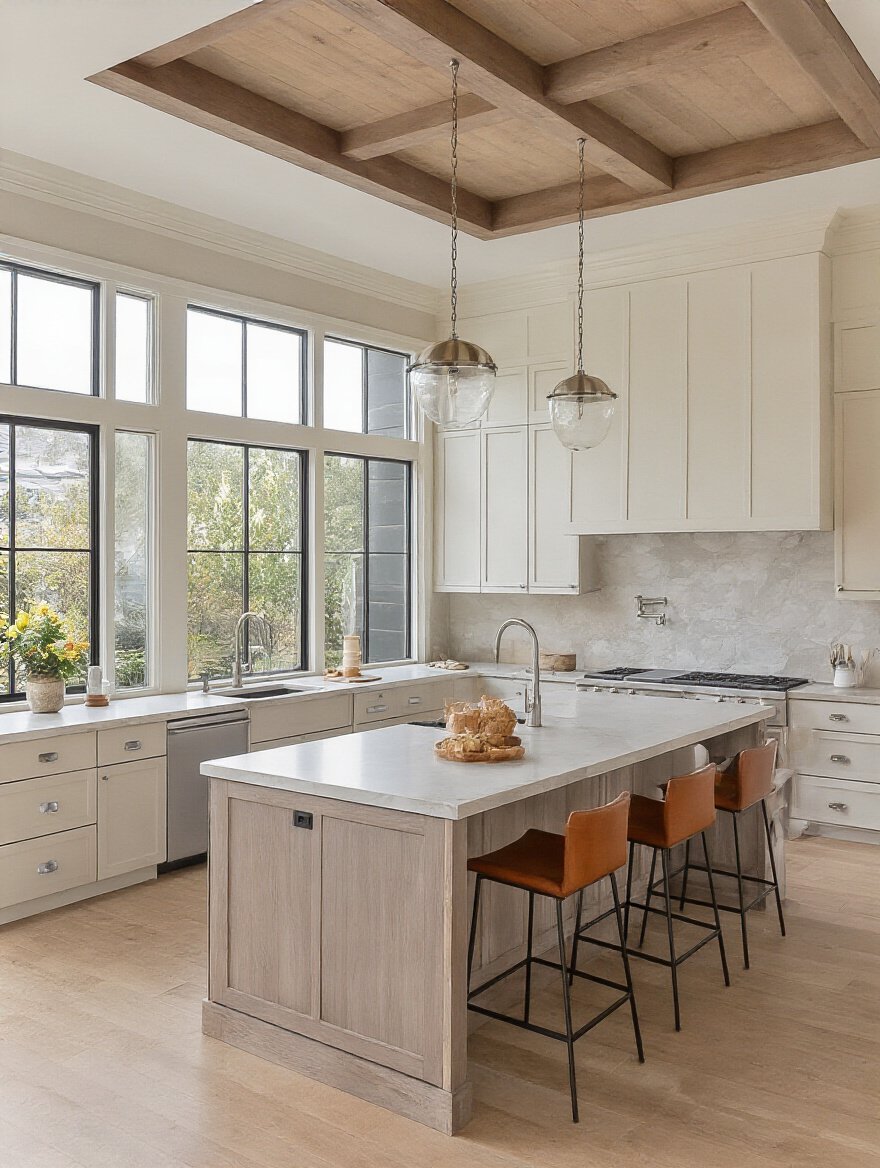
The goal is to minimize wasted steps and frantic running around. When I design a kitchen, I walk through the process of making a simple meal, from taking ingredients out of the fridge to plating the final dish. Every step should feel natural and intuitive. For entertaining, you need clear pathways so guests can grab a drink or mingle without getting in the cook’s way. A big island with seating on one side is great, but make sure the working side is protected.
This focus on flow is what separates a pretty kitchen from a kitchen that’s a true workhorse. It’s the invisible magic that makes everything feel easier.
5. Integrate Smart Home Automation from the Initial Blueprint Stage
Okay, don’t let the term “smart home” scare you off. We’re not talking about some futuristic robot kitchen you can’t figure out. This is about making your life genuinely easier, but it has to be planned from the very beginning. It’s much harder and more expensive to add this stuff in later. Think about putting outlets inside a specific cabinet to create a hidden charging station or an “appliance garage” for your toaster and blender. Think about layered lighting you can control with your voice or a single button—”Dinner Party” mode, anyone?
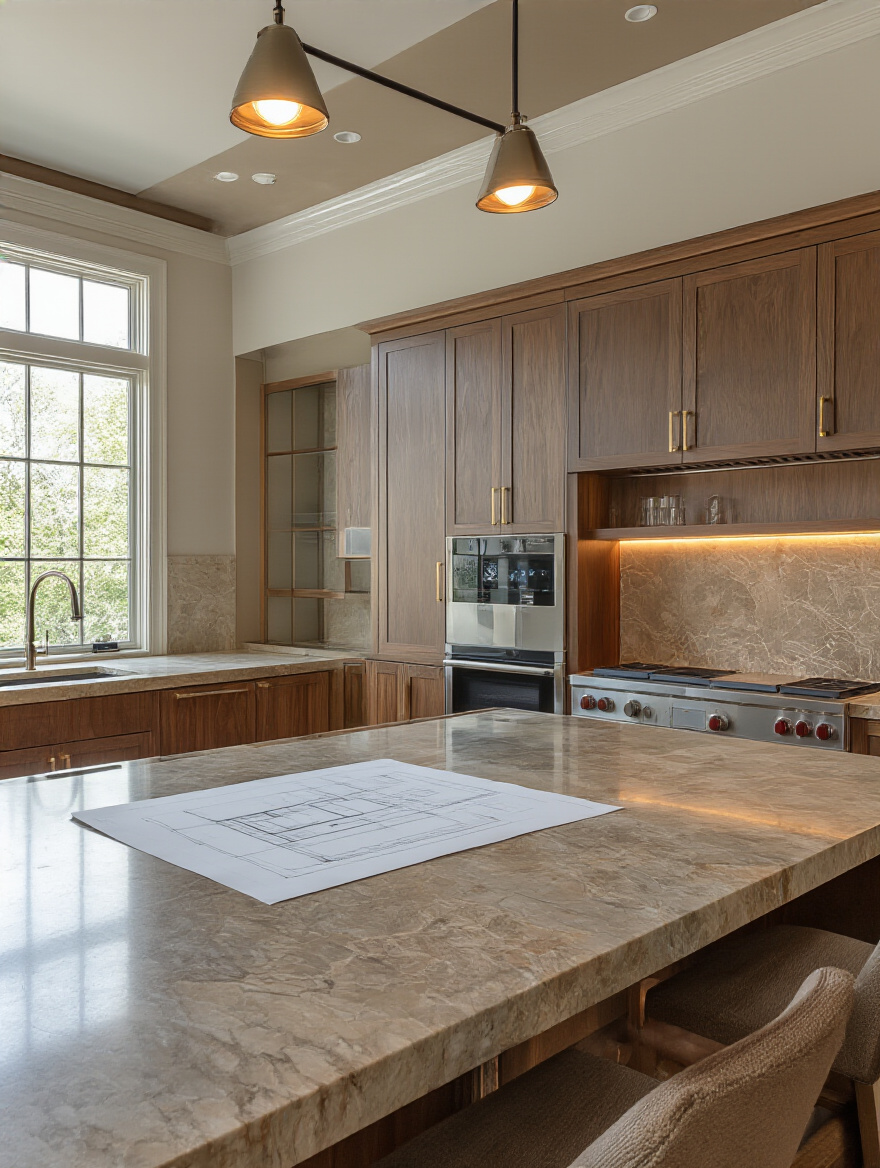
I once had clients who wanted a completely seamless look, so we planned for a pop-up outlet tower in their island and a smart faucet that was voice-activated. It meant their gorgeous stone island was completely uninterrupted by outlets or handles. But that only worked because the electrician and the plumber were in on the plan before the walls were even framed.
Thinking about the wiring and placement of these smart features from the blueprint stage ensures they feel integrated and intuitive, not like a clumsy afterthought.
6. Conduct a Detailed Site Assessment and Structural Feasibility Review
Before you knock down a single wall or even order a cabinet, you have to get a structural engineer or a really experienced architect in there to do a full assessment. This is like getting an x-ray before surgery. They’ll tell you which walls are load-bearing, whether your floors can actually support the weight of a two-ton stone island, and if your plumbing and electrical systems can handle the demands of professional-grade appliances.
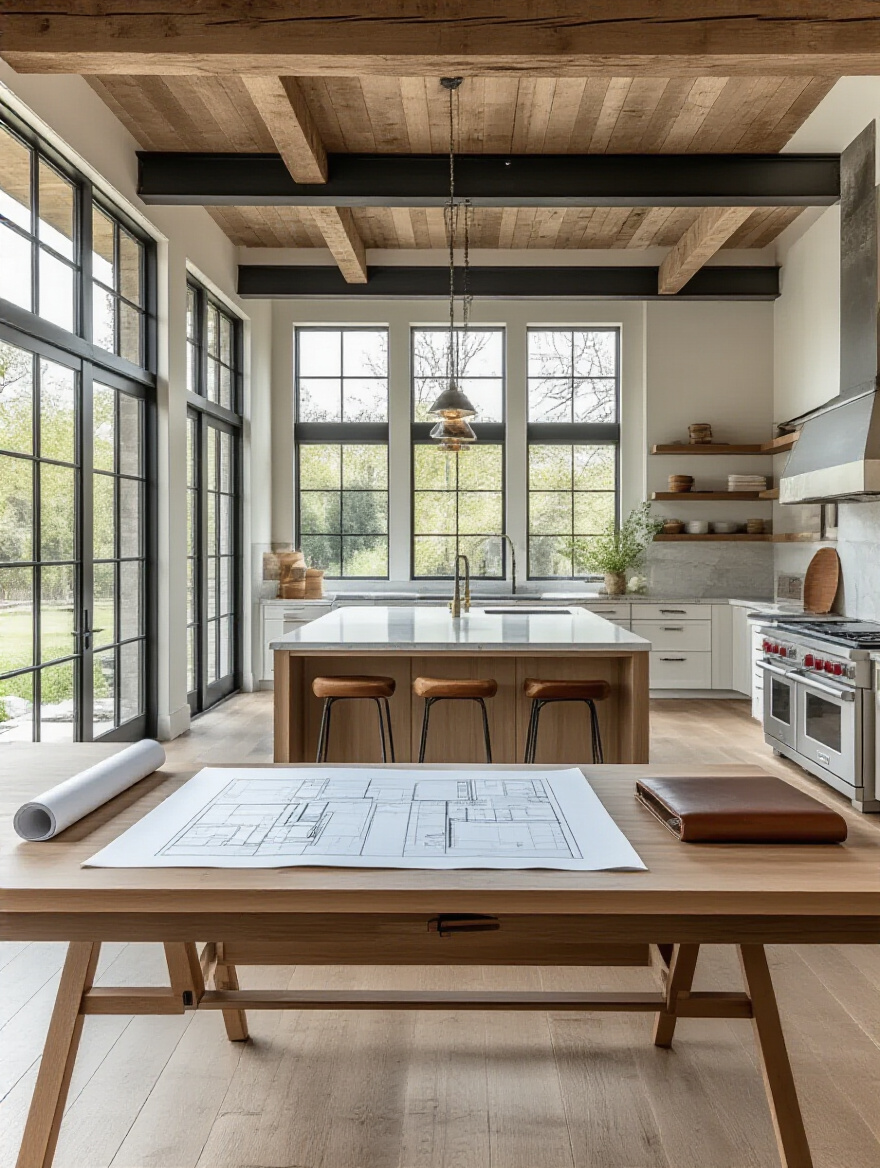
So many people skip this step because it’s not glamorous, and it costs money upfront. Huge mistake. I saw a project where the homeowner wanted a massive cast-iron range that weighed almost 1,000 pounds. They bought it without a structural review. Turns out, the floor joists in their 100-year-old home wouldn’t have even come close to supporting it. They had to spend a fortune reinforcing the entire floor from the basement up.
An early assessment prevents these kinds of budget-busting surprises. It’s the foundation upon which your entire beautiful—and safe—kitchen is built.
Exquisite Material Selection & Premium Build
Alright, now for the fun part! Once the plan is solid, we can talk about the materials and finishes that bring the space to life. This is where you create the look and feel, but remember—in a kitchen, function is just as important as beauty.
7. Select bespoke cabinetry with Custom Storage Solutions and Finishes
Here’s a little secret: Bespoke cabinetry isn’t just about choosing a pretty color. It’s about solving all those little annoyances in your current kitchen. It’s the magic of a pull-out drawer perfectly designed for your spices, a deep cabinet with vertical dividers for your baking sheets, or a hidden “appliance garage” with outlets inside, so your countertop stays clear of the toaster and blender. This is what truly elevates a kitchen.
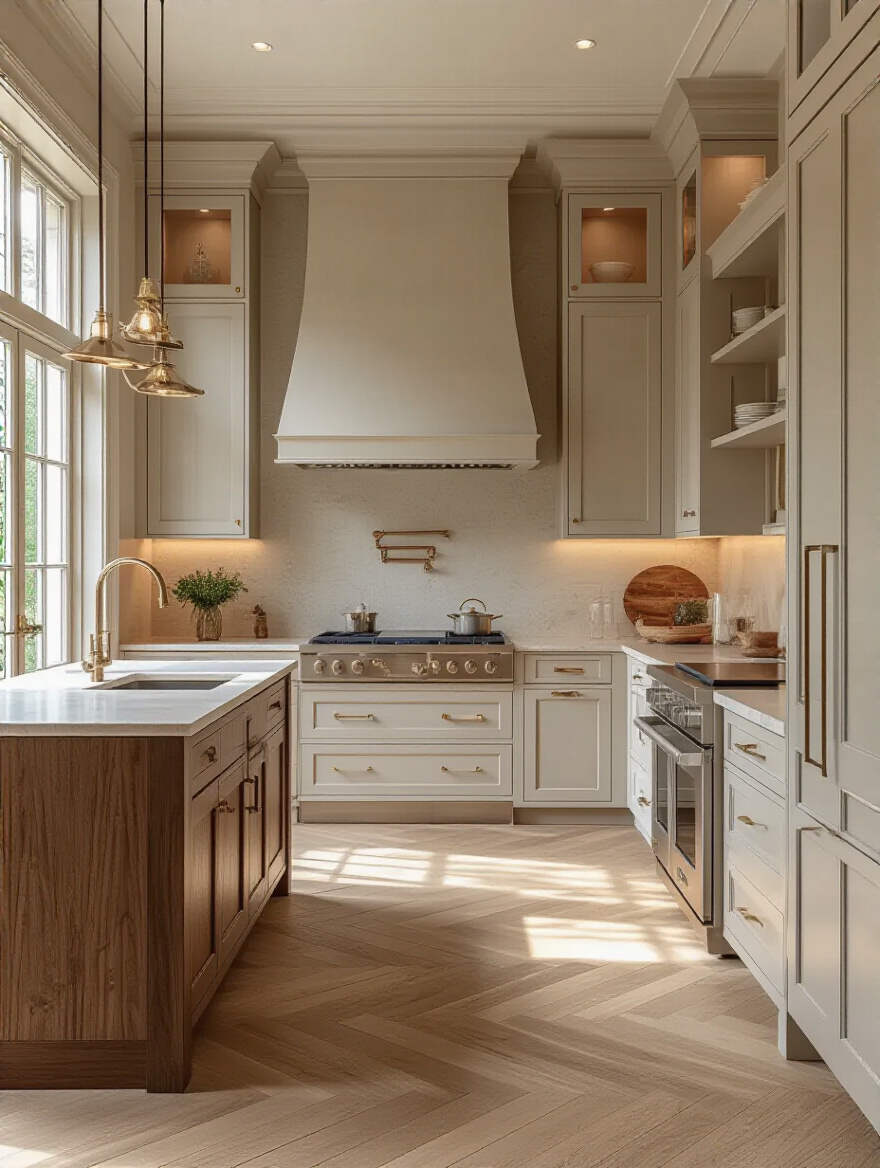
Stock cabinets force you to live with their limitations. Custom cabinets are built around your items and your workflow. I worked with a serious home chef who had an extensive collection of oils and vinegars. We designed a custom pull-out pantry right next to the stove, with narrow shelves perfectly sized for the bottles. It completely streamlined his cooking process. You can’t get that kind of tailored solution off the shelf.
This is an investment, for sure, but it’s one that pays you back every single day in pure, unadulterated functionality and joy.
8. Invest in Premium Countertops: Natural Stone, Exotic Wood, or High-Grade Composites
The countertop is the work surface of your kitchen, but it’s also one of the biggest visual statements. So let’s be real about the options. Everyone says they want marble, and it is undeniably stunning. But I always tell my clients, “Are you willing to embrace the patina?” Marble is soft and porous. It will etch if you spill lemon juice on it, and it will stain if a drop of red wine sits for too long. For a baker, a cool slab of marble is heaven. For a family with three young kids? It can be a constant source of stress.
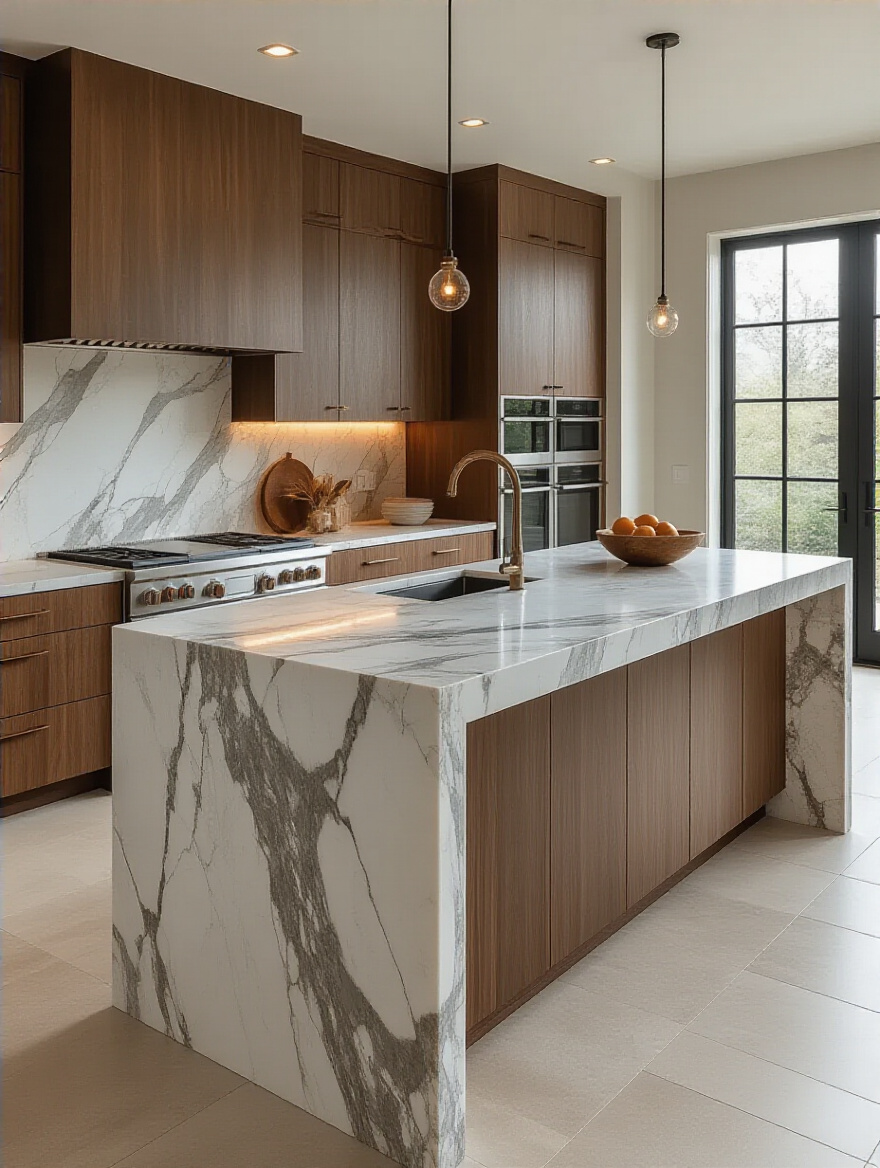
High-grade composites like quartz are the opposite—they’re practically bulletproof. You can spill anything on them, and they won’t stain or etch. The trade-off is that some people find they lack the unique, natural soul of real stone. Then you have things like beautiful butcher block, which is warm and wonderful for chopping, but it requires regular oiling and care. The “right” choice is the one that fits your cooking style and your tolerance for maintenance. Don’t let anyone tell you there’s one perfect material.
My best advice? Get samples. Take them home. Spill coffee on them. Put a hot pan on them (with a trivet!). See how they look in your home’s light. Live with them for a few days before you commit to covering your kitchen in them.
9. Choose High-Performance, Professional-Grade Integrated Appliances
Integrated appliances are the key to achieving that seamless, high-end look. This means your refrigerator, dishwasher, and even wine fridge are all fitted with custom cabinet panels so they disappear into the cabinetry. It creates a clean, uncluttered, and sophisticated aesthetic, turning the kitchen into a beautifully furnished room rather than just a utility space.
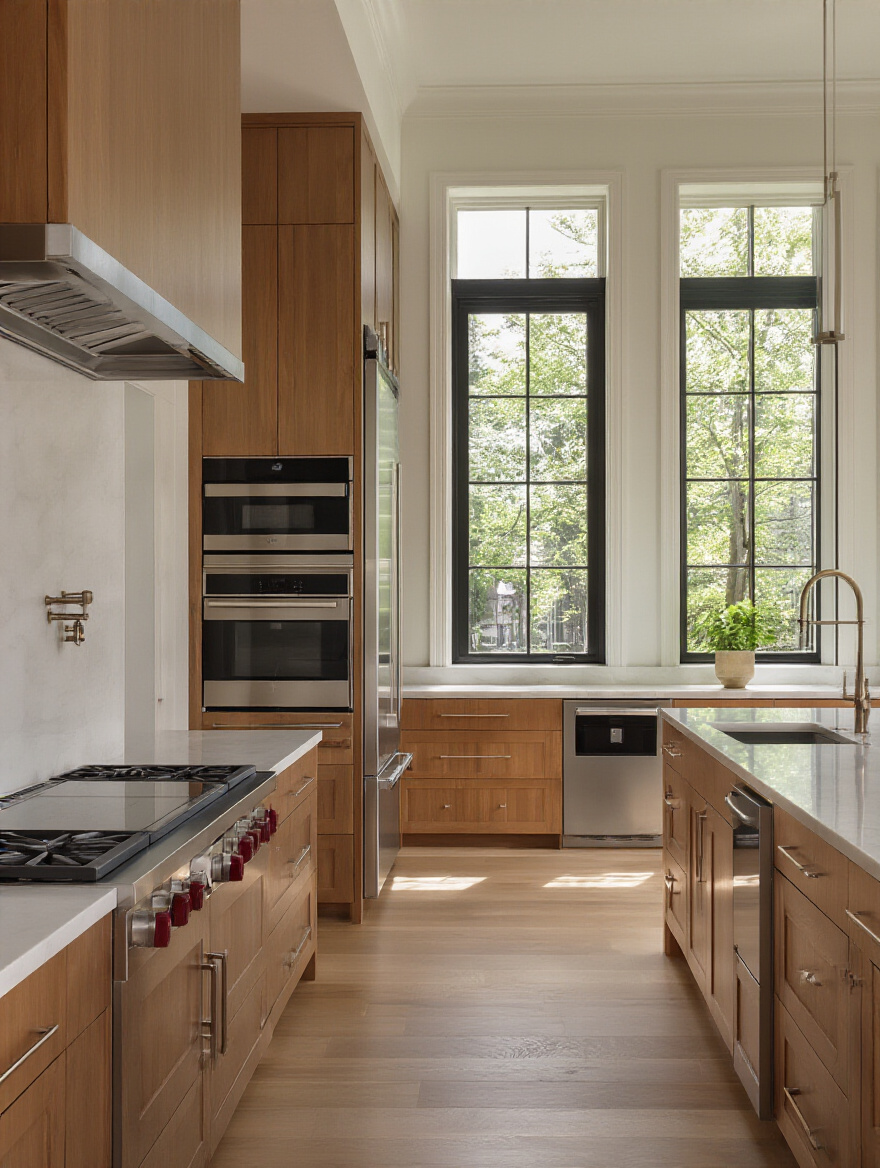
But here’s the thing everyone gets wrong: not all appliances that claim to be “panel-ready” are created equal. You need to work closely with your designer and cabinet maker to ensure the specs are perfect. A truly integrated appliance will sit perfectly flush with your surrounding cabinets, with no weird gaps or protruding handles unless that’s a deliberate design choice. It’s what separates a high-end, custom look from something that’s just “good enough.” And functionally, professional-grade appliances offer a level of precision—from the exact temperature control of an induction cooktop to the humidity zones in a refrigerator—that can completely change your cooking game.
When you’re making this level of investment, do your homework on brands known for their integration quality, like Sub-Zero, Miele, and Gaggenau. They’ve engineered their products to make this seamless look possible.
10. Install Designer Plumbing Fixtures, Faucets, and Custom Hardware
If cabinetry and countertops are the outfit, then faucets and hardware are the jewelry. These are the touchpoints you interact with every single day, so they should not only look beautiful but feel solid and substantial in your hand. This is not the place to skimp. A high-quality faucet has better internal mechanics and will last for decades, while a cheap one will start to leak and fail.
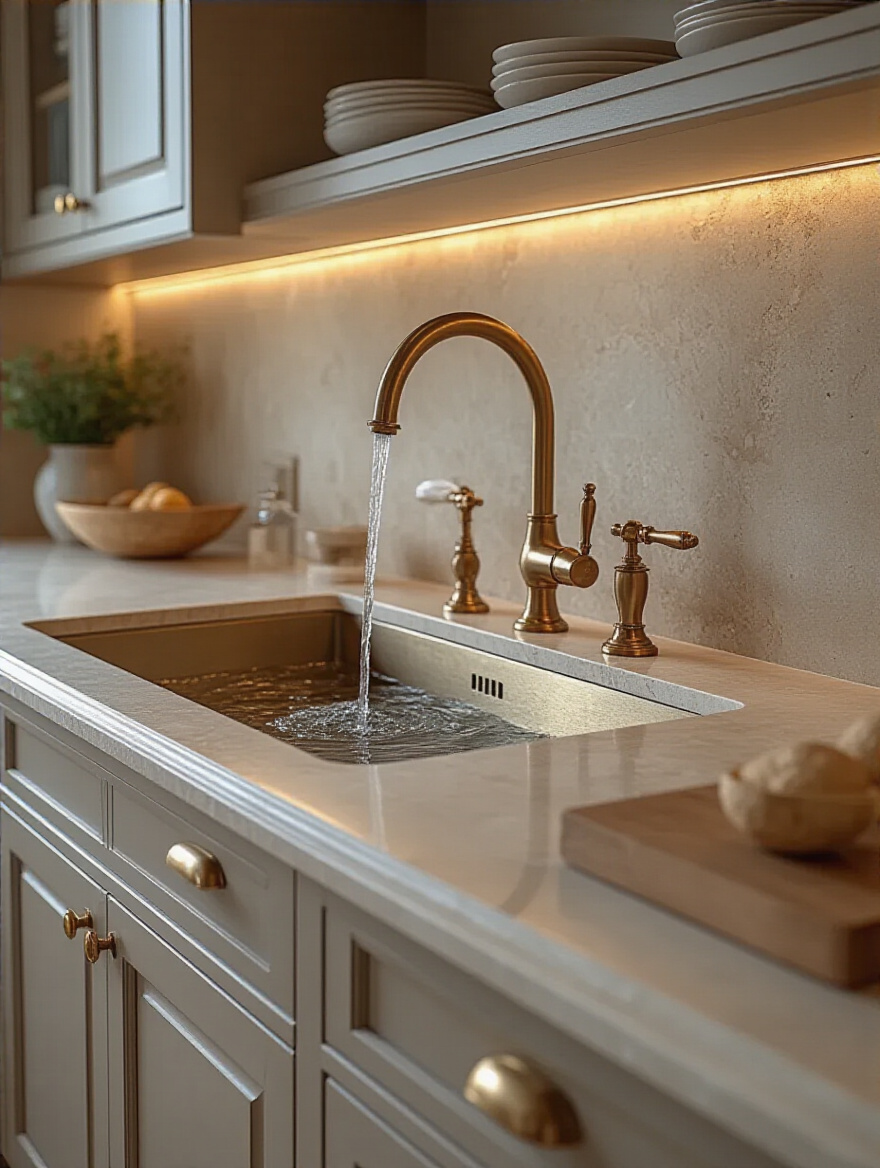
Here’s my biggest pet peeve: mismatched metal finishes. If you’re going with a beautiful aged brass for your cabinet pulls, make sure your faucet, pot filler, and even the light fixtures complement it. They don’t have to be from the exact same collection, but the tones should feel cohesive. And please, please, order physical samples! The “brushed gold” you see online can look totally different in your kitchen’s natural light. Seeing and feeling them in the actual space is non-negotiable.
This is where you can infuse so much personality, whether it’s with a sleek, minimalist faucet or with artisan-made cabinet knobs that feel like individual sculptures. These details are what make a kitchen feel truly custom and thoughtfully designed.
11. Opt for Luxurious Flooring Materials: Wide-Plank Hardwood or Large-Format Natural Stone
Your kitchen floor takes a beating. It needs to stand up to spills, dropped pots, and constant foot traffic. But it also sets the entire aesthetic tone for the room. Wide-plank hardwood brings a wonderful warmth and softness underfoot, which is a huge bonus if you spend hours standing while you cook. It seamlessly connects the kitchen to the rest of the home in an open-concept layout. The key is to choose a durable species and a high-quality finish that can withstand the rigors of a kitchen.
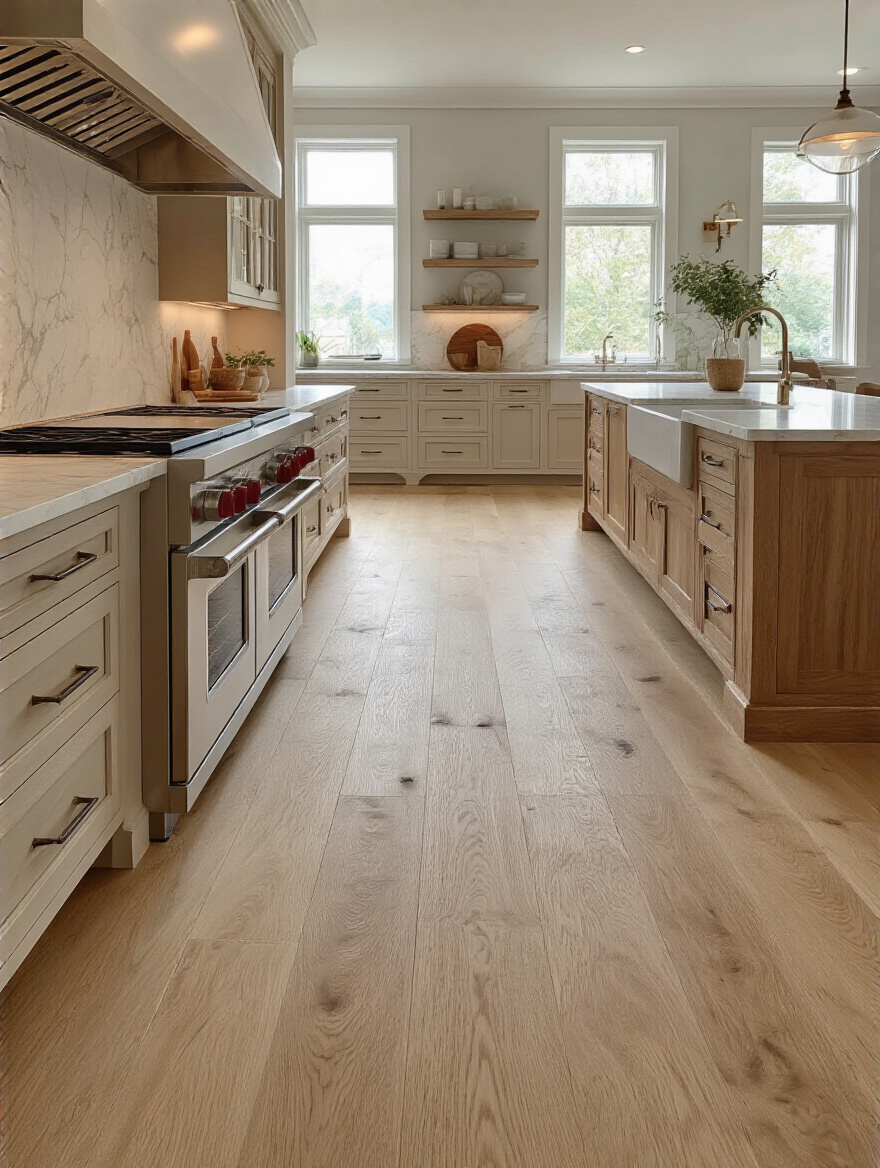
Large-format natural stone, like slate or limestone, offers a timeless, earthy elegance and is incredibly durable. The bigger tiles mean fewer grout lines, which creates a very clean, expansive look (and is much easier to clean!). But be warned: stone is hard. Standing on it for hours can be tough on your back and joints, and if you drop a glass, it’s guaranteed to shatter. For stone floors, I always recommend integrating radiant heating underneath. Trust me, stepping onto a warm stone floor on a cold morning is a luxury you will never regret.
No matter which you choose, proper installation is everything. A poorly laid floor will creak, crack, or warp, completely undermining your investment.
12. Ensure Impeccable Installation and Craftsmanship by Experienced Artisans
This might be the most crucial point of all. You can choose the most exquisite materials in the world, but if they are installed by someone who isn’t a true craftsman, the entire project will fall flat. The difference between a standard installer and an artisan is in the details: the perfectly mitered corners on a waterfall island, the imperceptible seam in a stone countertop, the whisper-close drawers that align to the millimeter.
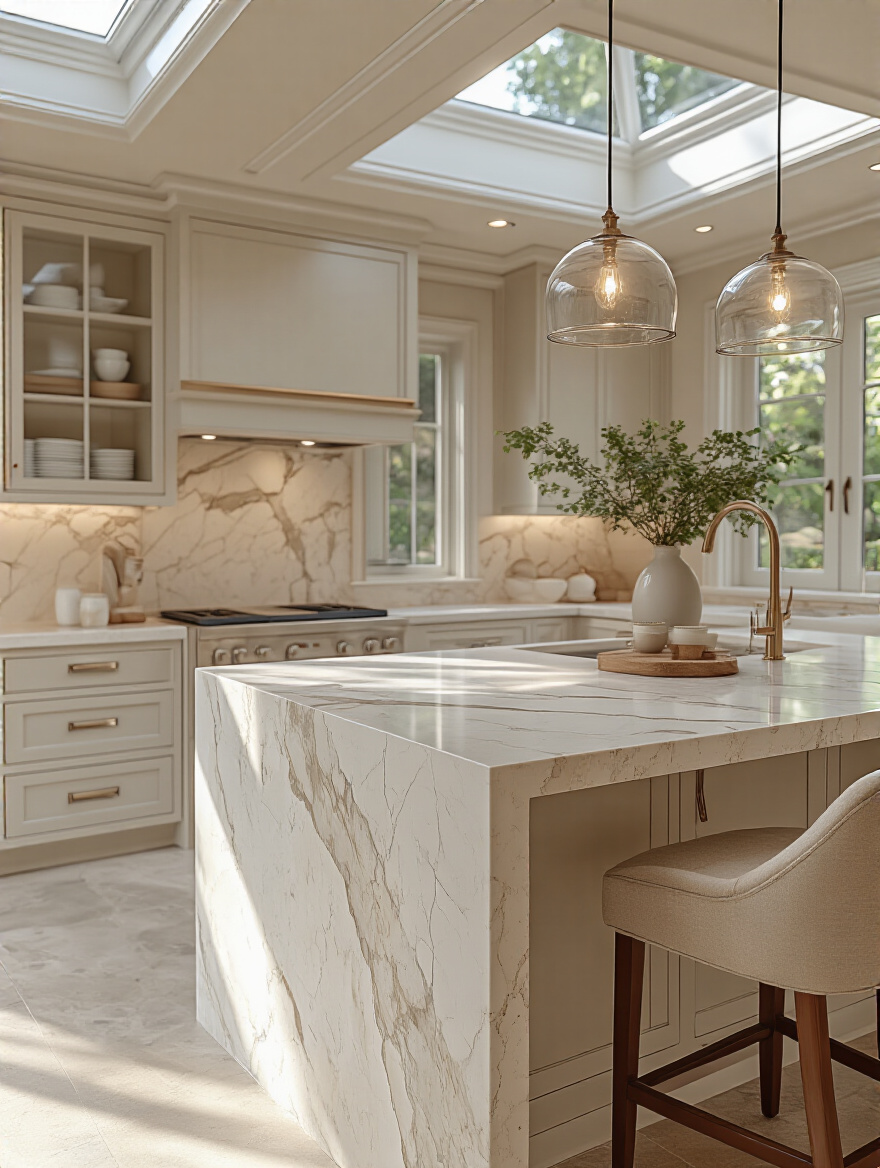
I always tell my clients to vet their installers as carefully as they vet their designer. Ask to see a portfolio of their finished work. Don’t just look at the big picture; zoom in on the details. Look at how the tile grout lines match up, how the crown molding meets the cabinetry, how the appliance panels sit flush. A true artisan takes immense pride in this precision.
Here’s a shortcut: hire the installer your stone supplier or custom cabinet maker recommends. They work with the best and won’t risk their reputation on someone who does shoddy work. Paying a little more for a master craftsman is the best insurance policy you can buy for your renovation.
Elevated Functionality & Bespoke Features
This is where we move from a great kitchen to an extraordinary one. These are the features that are tailored specifically to your passions and lifestyle, making every moment in the kitchen a little easier and a lot more enjoyable.
13. Design Dedicated Functional Zones: Coffee Bar, Wine Station, or Prep Pantry
Let’s be honest, the kitchen is never just for cooking. It’s the command center of the home. Creating dedicated zones for specific activities is a game-changer for maintaining sanity and order. A coffee and breakfast bar, complete with a great espresso machine, a drawer for mugs, and a small fridge for milk, keeps the morning chaos contained and out of the primary cooking area. It’s life-changing for a busy family.
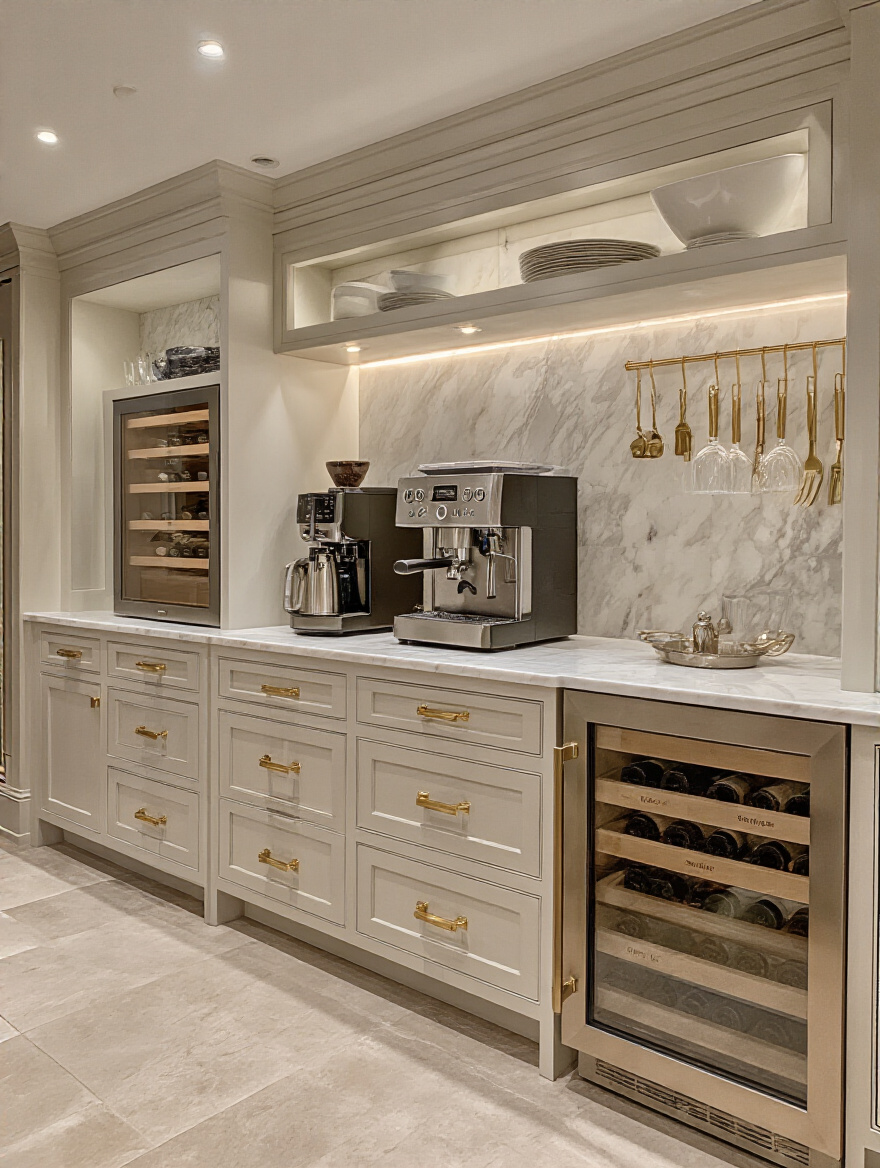
If you love to entertain, a dedicated wine or beverage station with a wine fridge, an ice maker, and storage for glassware allows guests to help themselves without ever getting in your way while you’re trying to finish dinner. And for serious home cooks, a “prep pantry” or scullery is the ultimate luxury. It’s a secondary space with a sink and counter where all the messy work—chopping, mixing, using small appliances—can happen, keeping the main kitchen pristine and ready for guests.
These thoughtful zones are what make a kitchen feel incredibly intuitive and custom-tailored to the rhythm of your household.
14. Integrate State-of-the-Art Ventilation Systems for Air Quality and Odor Control
This is not a glamorous topic, but it is so, so important, especially in an open-concept home. If you’re investing in a powerful, professional-grade range, you absolutely must invest in an equally powerful ventilation hood. A standard, off-the-shelf hood just won’t cut it. Searing a steak or stir-frying can produce a ton of smoke and grease, and without proper ventilation, that greasy film will end up on your cabinets, your furniture, and your light fixtures.
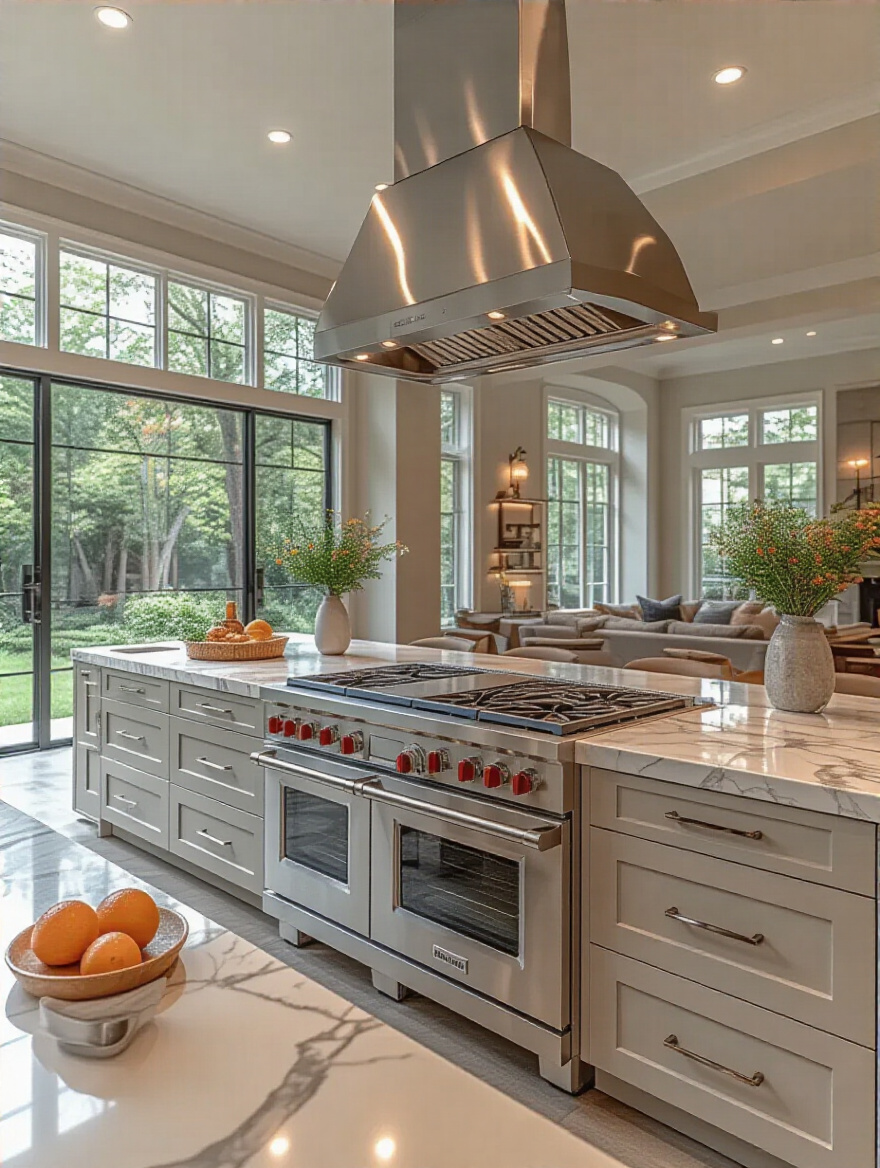
The key here is something called CFM, or Cubic Feet per Minute, which measures how much air the hood can move. Your designer or appliance specialist can help you calculate the right CFM for your specific cooktop. And here’s the BS everyone else says: don’t even consider a “ductless” or “recirculating” hood. They just filter some of the air and blow it right back into your kitchen. For a true luxury build, you need a system that is ducted to the outside. Period.
Look for models with quiet blower motors (some can even be located remotely, like in the attic, for near-silent operation) so you can actually hold a conversation while it’s running. This is a non-negotiable for a clean, fresh-smelling home.
15. Implement Intelligent and Layered Lighting Design for Ambiance and Task
If there is one thing that I see people get wrong over and over, it’s lighting. So many kitchens just have a single, harsh overhead light in the center of the ceiling, which casts shadows exactly where you’re trying to work! A truly great kitchen has layers of light that all serve different purposes.
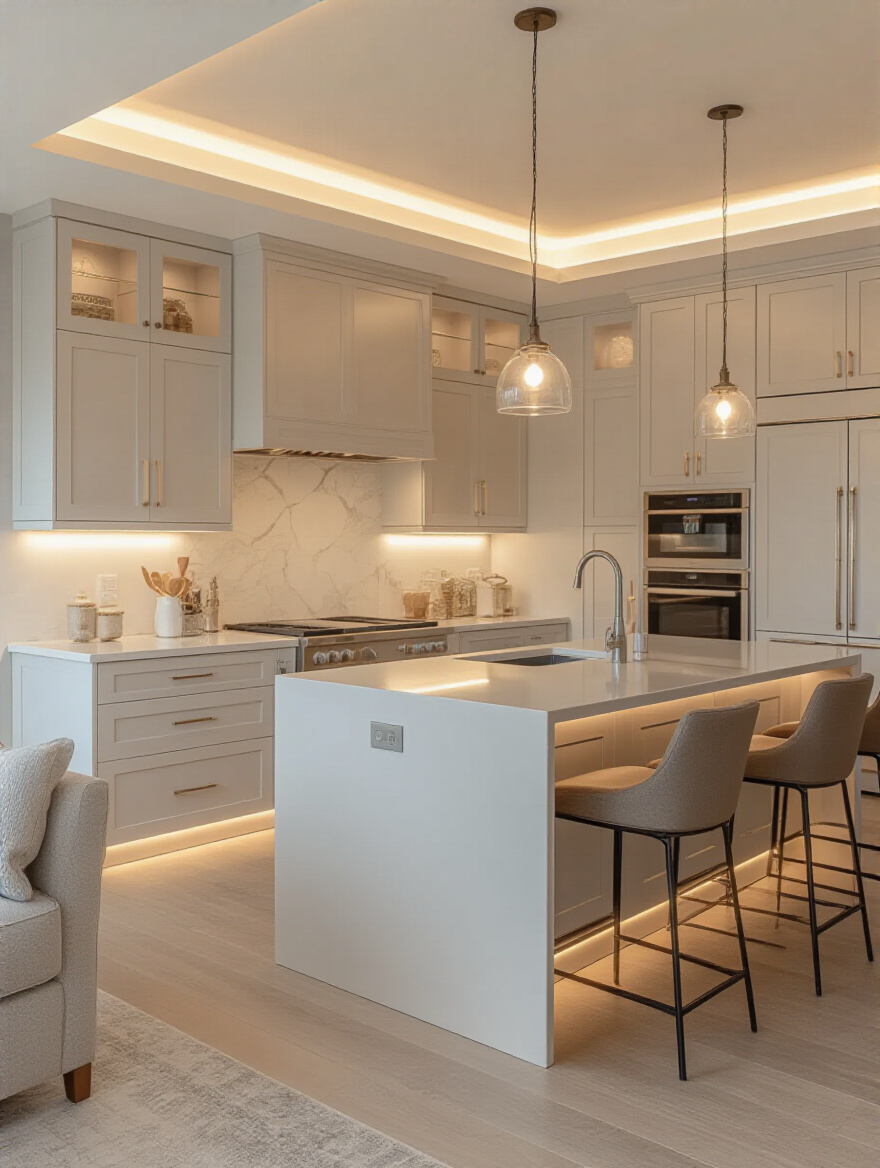
You need three main layers. First is task lighting: bright, focused light directly over your work surfaces. Under-cabinet lighting is the hero here—it illuminates your countertops beautifully without glare. Second is ambient lighting: the general, overall light for the room, usually from recessed cans or a beautiful ceiling fixture. And third is accent lighting: this is the fun stuff, like puck lights inside glass-front cabinets to show off your beautiful dishes or a stunning pendant light over the island that acts as a piece of art.
My shortcut for making it all work? Put. Everything. On. A. Dimmer. This gives you complete control. You can have it bright and energetic when you’re cooking, then dim it all down for a warm, intimate glow when you’re enjoying dinner with family or friends.
16. Specify an Integrated Waste Management and Recycling System
Let’s talk trash. Literally. Nothing ruins the look of a sleek, beautiful kitchen faster than an ugly trash can sitting out in the open or a pile of recycling accumulating on the counter. A thoughtfully designed kitchen plans for this from the start, with integrated pull-out cabinets that conceal bins for trash, recycling, and even composting.
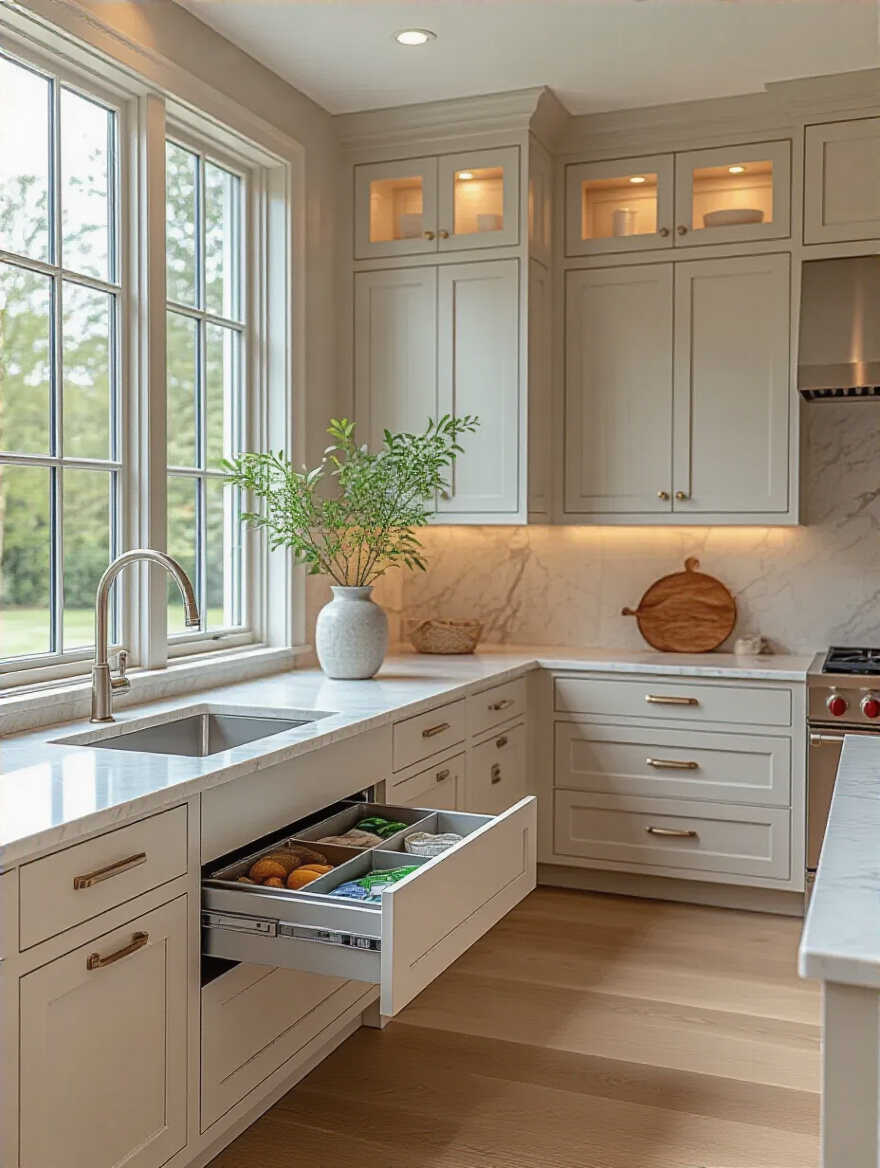
This isn’t just about aesthetics; it’s about function. The best place for these is right next to your sink and main prep area, where you generate the most waste. Think about systems that have multiple bins in one pull-out, making sorting a breeze. Some high-end systems even have soft-close mechanisms and lids to contain odors.
This might seem like a small detail, but it makes a huge difference in keeping your kitchen clean, organized, and running smoothly. It’s one of those invisible luxuries that you’ll appreciate every single day.
17. Add a Professional-Grade Prep Sink or Wall-Mounted Pot Filler
These are the features that make you feel like a professional chef in your own home. A small “prep sink” on the kitchen island is a total game-changer, especially if two people are often cooking at the same time. It creates a completely separate workstation for washing vegetables or filling a pot, leaving the main sink free for cleanup duty. It single-handedly resolves so many kitchen traffic jams.
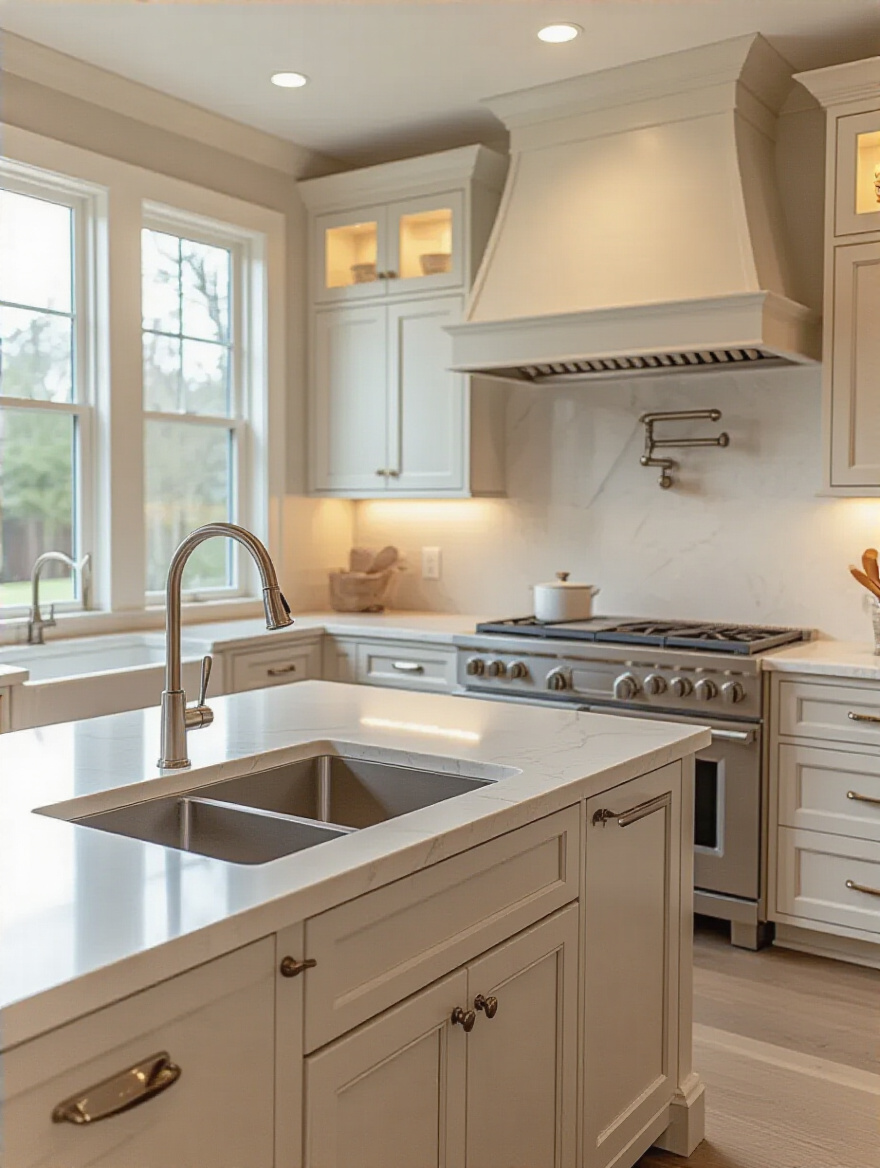
And a pot filler? It’s a faucet on an articulating arm mounted on the wall right over your range. It might seem like an indulgence, but if you’ve ever lugged a massive, heavy pot of water from the sink to the stove for pasta or soup, you will understand the pure genius of this thing. It reduces strain on your back and minimizes the risk of spills.
These are not just trendy gadgets; they are smart, ergonomic solutions that streamline the real work of cooking.
18. Curate Bespoke Art, Decor, and Styling Elements that Reflect Your Persona
Please, please do not let your finished kitchen look like a sterile showroom. This is the heart of your home! It needs to have soul. This is the final layer that makes the space uniquely yours. It could be a beautiful piece of art hanging on a wall, a collection of handmade pottery on an open shelf, or even just a stunning wooden bowl that you keep filled with seasonal fruit.
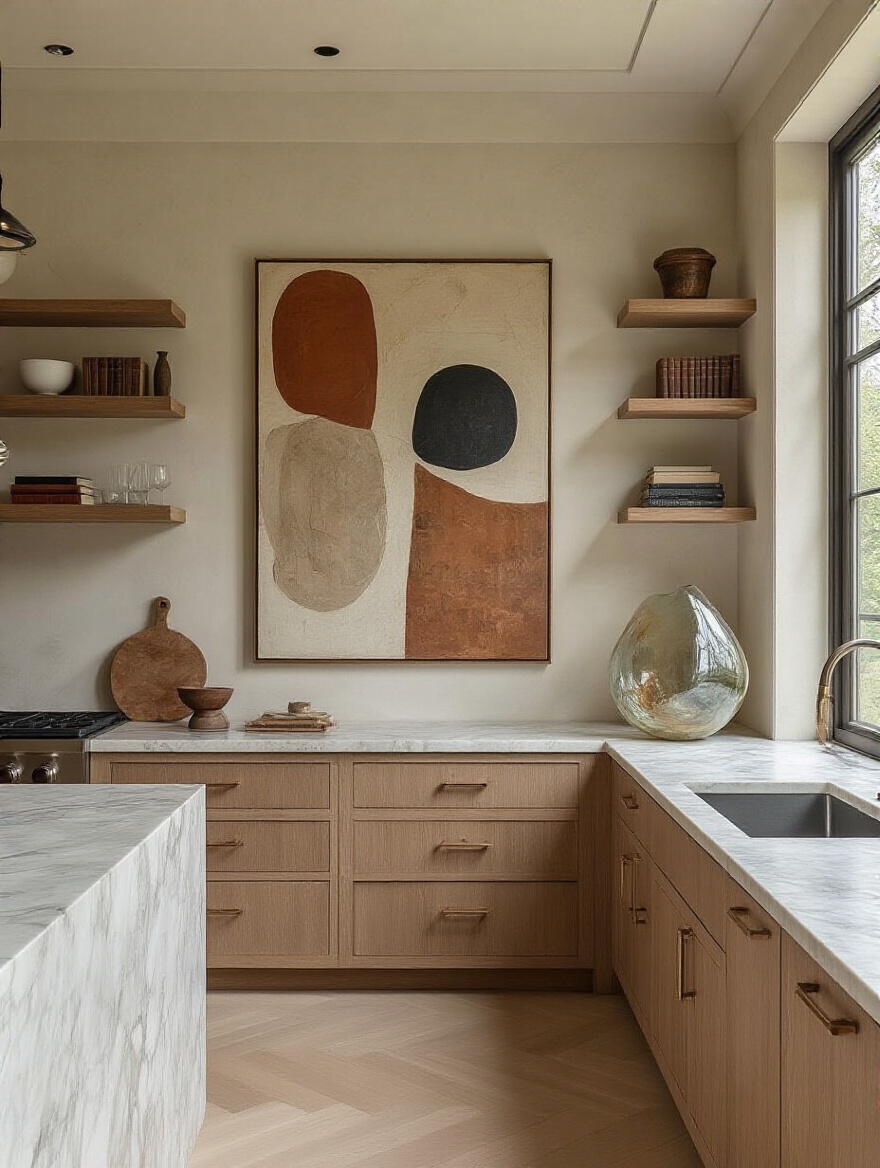
Don’t be afraid to mix old and new. An antique runner can add so much warmth to a sleek, modern kitchen. A framed recipe handwritten by your grandmother can be more meaningful than any expensive print. This is where your personality comes in.
My one piece of advice here is to curate, don’t clutter. You’ve just created a beautiful, functional space, so don’t cover every surface with knick-knacks. Choose a few meaningful pieces that bring you joy and let them shine.
19. Select Climate-Controlled Pantry Solutions for Optimal Food Preservation
For anyone who is serious about food—whether it’s wine, artisanal cheese, or just high-quality olive oil and spices—a climate-controlled pantry is the ultimate feature. This is far more than just a closet with shelves. It’s a dedicated space where you can control the temperature and humidity to create the perfect environment for preserving the life and flavor of your ingredients.
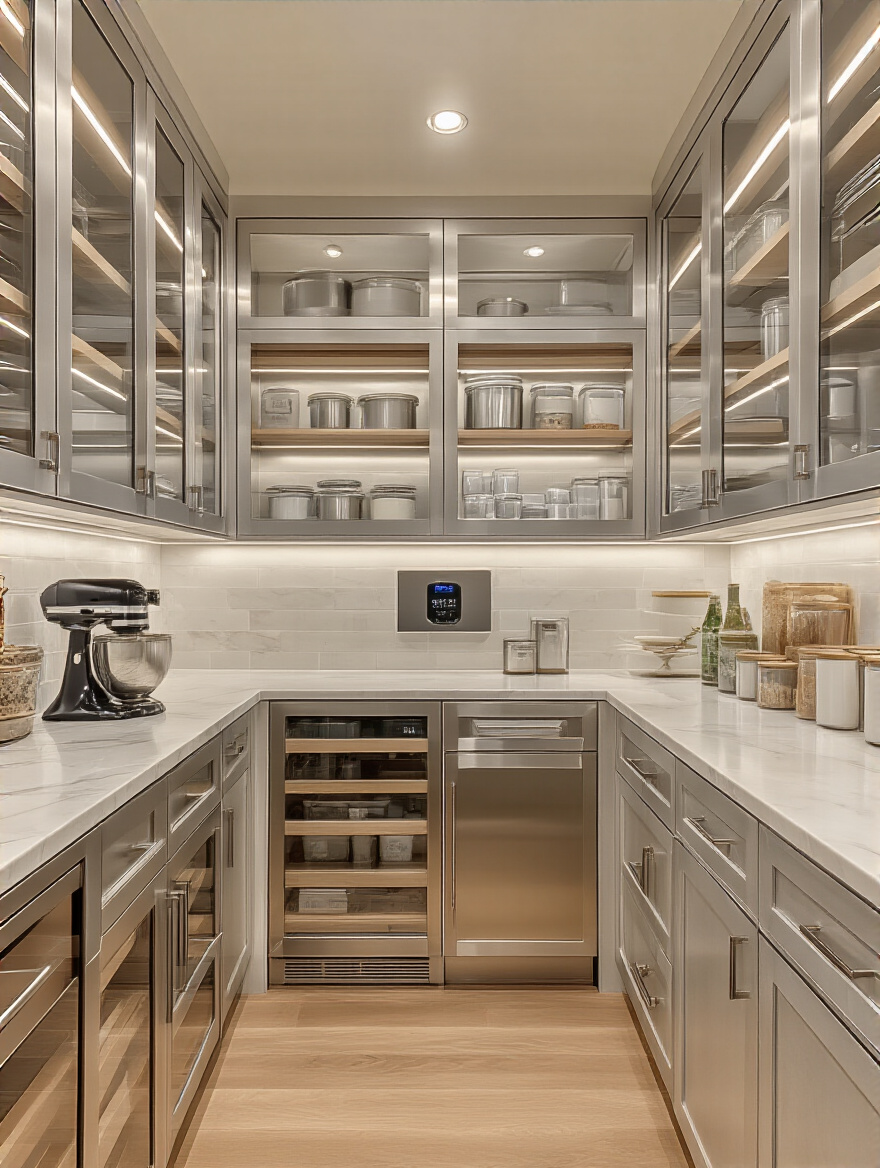
Heat, light, and humidity are the enemies of so many pantry staples. They can make expensive oils go rancid, spices lose their potency, and fine chocolates develop that white “bloom.” A proper climate-controlled pantry, kept cool and dark, protects that investment. For wine lovers, a dedicated section can keep your bottles at the perfect serving or cellaring temperature.
This is a true luxury, but for a passionate cook or entertainer, it ensures that your high-quality ingredients are always at their absolute peak when you’re ready to use them.
20. Plan for Advanced Water Filtration and Instant Hot/Cold Dispensing Systems
Once you have an instant hot water dispenser, you will wonder how you ever lived without it. It’s a small, dedicated faucet next to your main sink that delivers near-boiling water on demand. It’s incredible for making a quick cup of tea, jump-starting a pot of water for pasta, or loosening a stubborn jar lid. It’s a massive time-saver and convenience that you’ll use constantly.
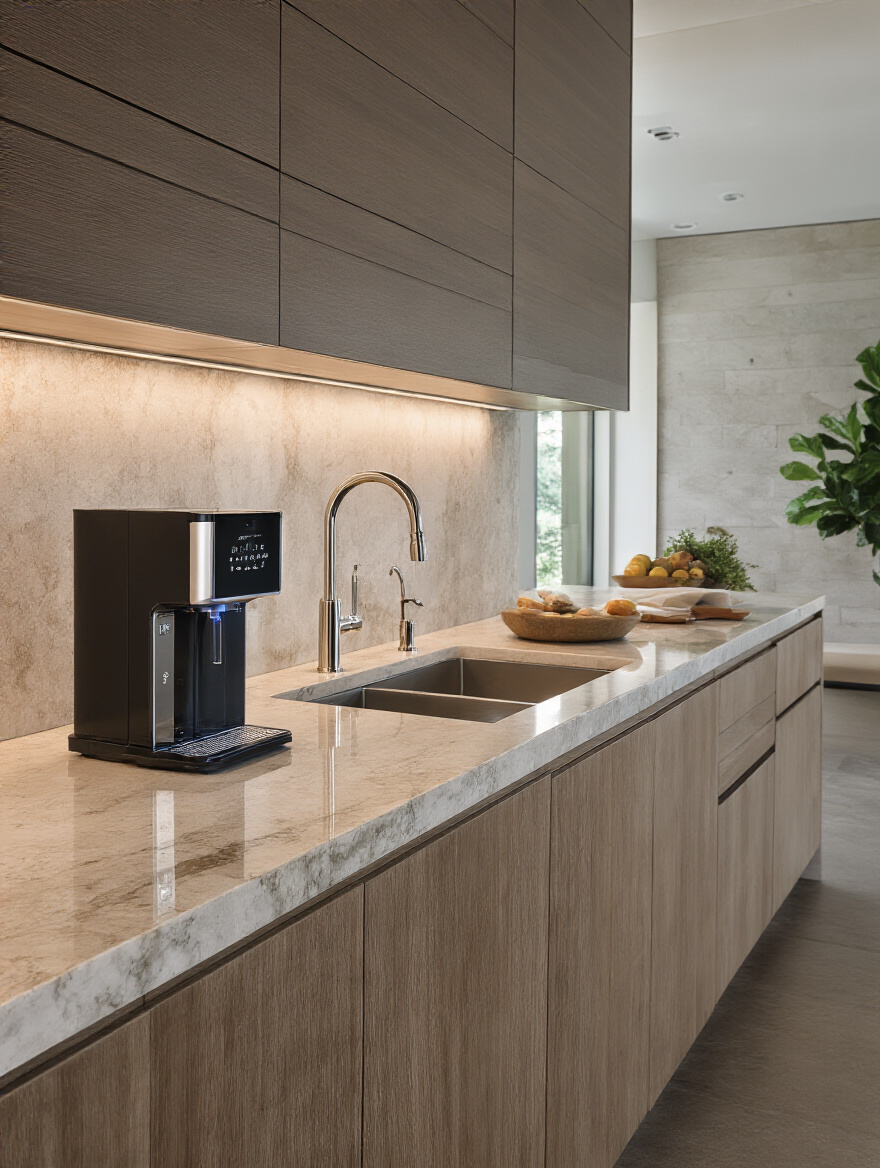
Pair that with a high-quality water filtration system, and you’ll have pure, delicious drinking water right at your fingertips. These systems can be integrated under the sink to remove chlorine, lead, and other impurities, giving you water that tastes better and is healthier for you. Many systems now offer filtered, chilled, and even sparkling water from a single tap. It’s a wonderful luxury that also reduces your reliance on single-use plastic bottles.
This is an investment in convenience, health, and sustainability, all rolled into one sleek fixture.
21. Incorporate Acoustic Solutions for Enhanced Comfort and Reduced Noise
Here’s the hidden element that no one talks about until it’s too late: sound. Modern kitchens, with their open-concept layouts and abundance of hard surfaces like stone, tile, and stainless steel, can be incredibly noisy. The sound of the vent hood, the dishwasher, and clanking pots and pans can bounce around the room, making it feel loud and chaotic—like you’re cooking in a canyon.
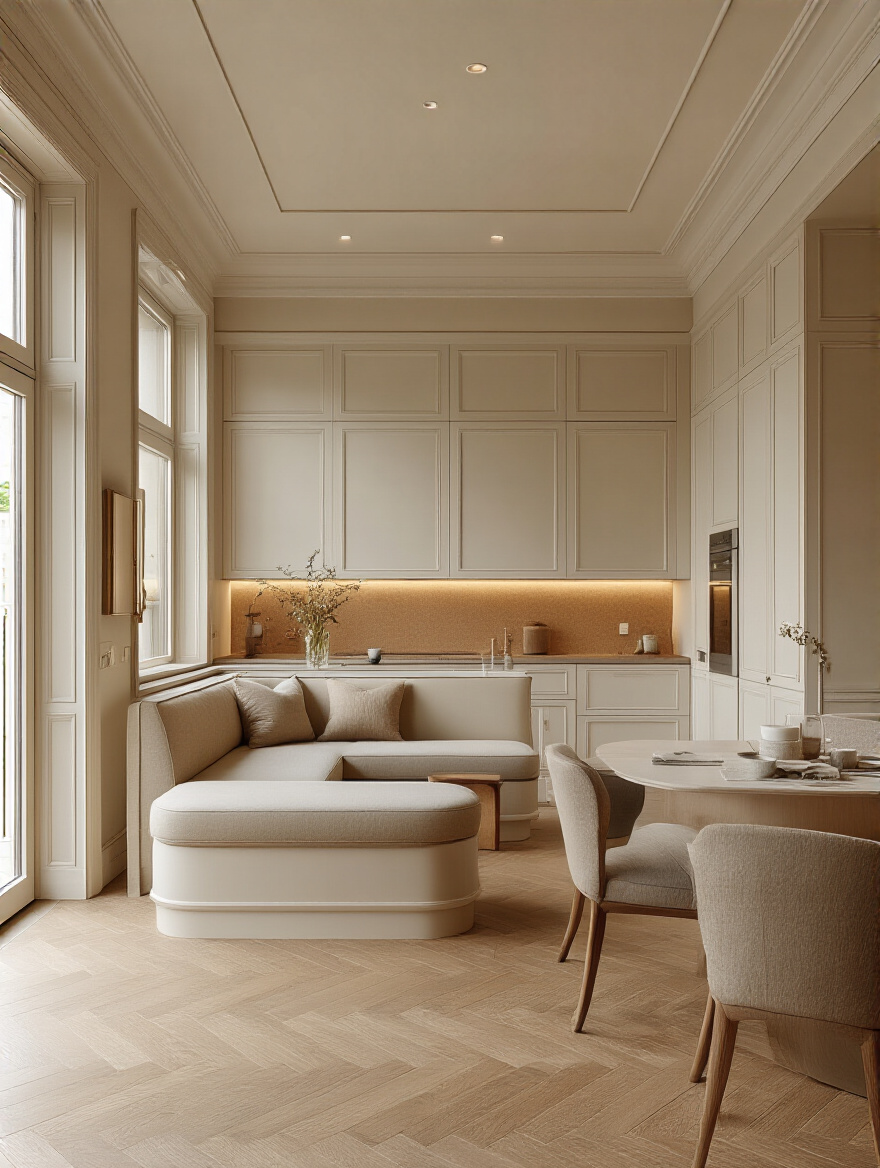
Incorporating acoustic solutions from the beginning makes a world of difference. This doesn’t mean you have to hang ugly foam panels on your walls. It can be as simple as choosing cabinetry with solid wood construction, adding a beautiful runner on the floor, or using upholstered bar stools or a banquette. Even adding drapes to a nearby window can help absorb sound. For a truly high-end solution, you can use specialized acoustic plaster or discreetly integrated wood slat panels on the ceiling.
Creating a kitchen that is acoustically comfortable—where you can easily have a conversation without shouting over the din—is the final, invisible touch of true luxury design.
Conclusion
So there you have it. Creating a truly exceptional kitchen is so much more than picking out pretty things. It’s a thoughtful process of designing a space that perfectly supports and enhances your life. It’s about seamless flow, impeccable craftsmanship, and those bespoke details that bring you joy every single day.
Forget the chaos of that holiday dinner we imagined. Instead, picture a space where everything is in its place, where guests can gather comfortably while you cook, and where the room itself feels as good as the food you’re creating. That isn’t a fantasy; it’s the result of smart planning and a focus on what really matters. It’s an investment not just in your home’s value, but in your daily happiness. Now, let’s go build your dream kitchen.
